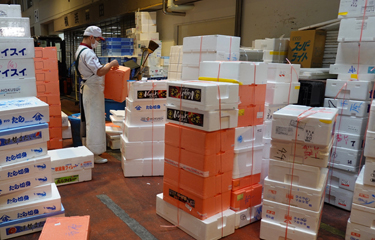Weak yen boosts overseas profits for Japan's big seafood players

Japan’s major seafood companies are feeling both negative and positive effects from a weakening of the country's currency.
Japanese importers must pay more to purchase seafood and transportation, and are having a hard time passing on higher costs to consumers, as Japan’s wages have been flat for over two decades. However, profits repatriated from the United States look larger when reported in yen.
Examples of seafood items that have seen major price jumps are salmon and surimi. The average import price of frozen coho salmon from Chile rose to JPY 1,100 (USD 7.86, EUR 7.58) per kilogram in September, up from a little over JPY 700 (currently USD 5.00, EUR 4.82) a year earlier. The import price of frozen surimi jumped to around JPY 535 (USD 3.82, EUR 3.69) per kilogram from around JPY 390 (USD 2.79, EUR 2.69) per kilogram.
Maruha Nichiro, based in Tokyo, revised its consolidated earnings forecast for fiscal year ending March 2023 upwards on 7 November to reflect its recent performance. The new forecast ups the company's net sales 7 percent and operating income by 21.5 percent, while the forecast for the company's ordinary income was increased by 28 percent and total profit was revised upward by 18.8 percent.
In the second quarter, which ran from July through September, Maruha Nichiro's processed foods business and foodstuff distribution business reported a decrease in operating income due to soaring raw material and energy costs and an increase in procurement costs caused by the rapid depreciation of the yen. But Maruha Nichiro reported stronger sales of pet foods and marine products in Europe and North America. And its aquaculture business unit reported higher operating income due to increased sales of tuna and yellowtail and rising market prices, resulting in a significant increase in overall group operating income.
Maruha Nichiro said beginning in Q3 2022, it will face an even more challenging business environment due to a trend of higher costs and yen depreciation are expected to continue, with a resulting drop in consumption as consumers face higher market prices.
Another major Japanese seafood player, Nissui, also based in Tokyo, released its financial results for the second quarter of FY 2022 on 8 November, showing it increased sales 11 percent year-on-year due to favorable seafood market conditions, food product mark-ups, and yen depreciation. It also reported a sales expansion, though its operating income decreased slightly. It said consumption of marine products in Japan continued to swing upwards following a rise beginning in Q1 2022.
“Fish prices [increased], resulting in increased sales and profits. Sales of food products increased, but profit significantly decreased due to cost increases,” the company said in its annual financial report.
Nissui's Operating profit fell 3.8 percent and its ordinary profit dropped 8.9 percent year-on-year. Nissui's marine products processing unit recorded strong sales both in Japan and overseas due to increased demand for marine products and rising prices. And its profits in North America rose due to the depreciation of the yen and lower costs for COVID-19 countermeasures.
But Nissui's food products unit, which deals in diverse foods including canned and bottled fish products, fish sausage, and frozen food for home consumption, reported a worsening performance.
"Although we raised prices in Japan and overseas, we could not keep up with the rapid increase in the cost of raw materials. As a result, operating profit decreased," the company said.
The company, like many Japanese food producers, raised prices in response to higher costs, but its price-hikes have not kept up with inflation, cutting into profits. In Q2 2022, Nissui said higher prices for raw materials cost the company JPY 4.4 billion (USD 31 million, EUR 30.2 million) more year-on year, and logistics costs cost it JPY 600 million (USD 4.2 million, EUR 4.1 million) more. Price increases for products only made up for 62 percent of the increase. In North America, the situation was less severe, as its price hikes covered 80 percent of the cost increases.
As with Maruha Nichiro, Nissui has revised its profit forecast for the full year upward, but this is mainly due to the sale of its subsidiary, Nissui Pharmaceutical. The company said it expects the gap between prices and costs to continue through at least the next quarter.
“Additional price increases for food products are planned, but the rise in raw material prices and the impact of foreign exchange rates will not fully be covered by the end of this fiscal year,” it said.
The average yen-dollar exchange rate in the second quarter of FY 2021 was JPY 109.76 to USD 1.00, but in the same period of 2022, it was JPY 131.25 – a weakening of the yen by 19.6 percent. In Nissui's accounting of its profits from overseas subsidiaries, this accounted for a gain of JPY 11.5 billion (USD 81 million, EUR 79 million). The euro and the Danish krone, however, only gained 4.8 and 4.7 percent, respectively, against the Japanese currency, and as a result, the company's European trading was less affected by exchange rates.
Photo courtesy of HAPIN/Shutterstock






Share